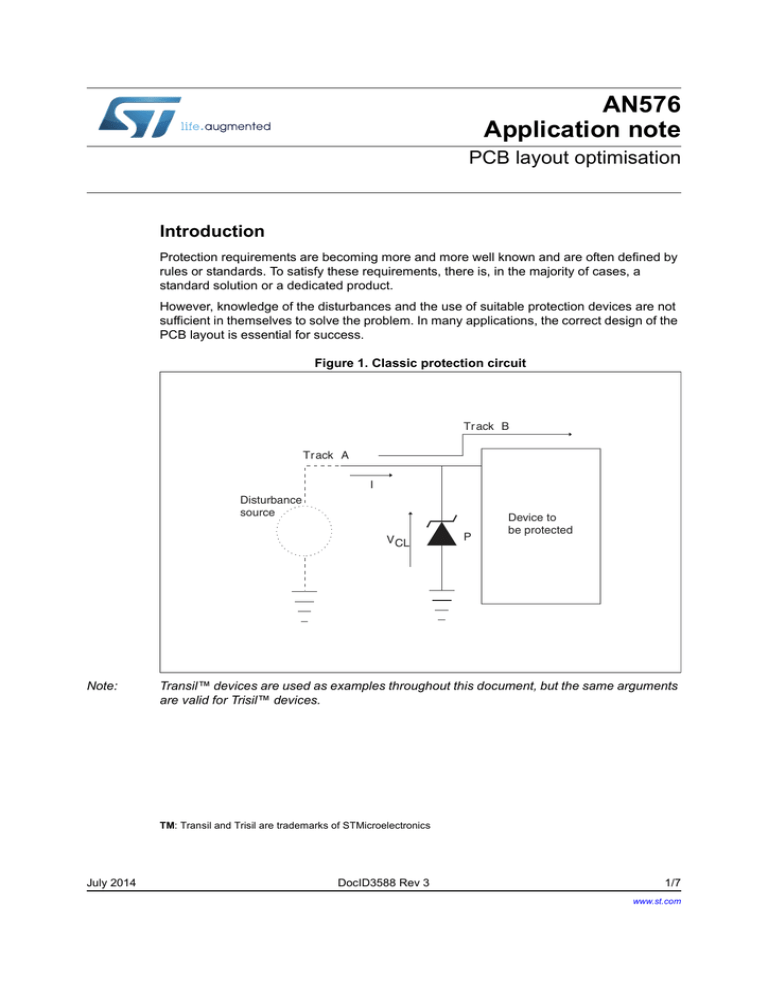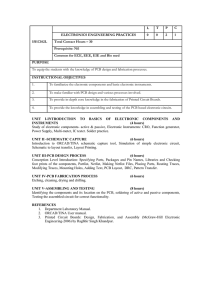
AN576
Application note
PCB layout optimisation
Introduction
Protection requirements are becoming more and more well known and are often defined by
rules or standards. To satisfy these requirements, there is, in the majority of cases, a
standard solution or a dedicated product.
However, knowledge of the disturbances and the use of suitable protection devices are not
sufficient in themselves to solve the problem. In many applications, the correct design of the
PCB layout is essential for success.
Figure 1. Classic protection circuit
Tr ack B
Tr ack A
I
Disturbance
source
V CL
Note:
P
Device to
be protected
Transil™ devices are used as examples throughout this document, but the same arguments
are valid for Trisil™ devices.
TM: Transil and Trisil are trademarks of STMicroelectronics
July 2014
DocID3588 Rev 3
1/7
www.st.com
7
Influence of the protection location
1
AN576
Influence of the protection location
The circuit presented in Figure 1 shows the classic approach for the protection location.
Here the protection device is located close to the module to be protected. When a
disturbance occurs on the track A the Transil P clamps the surge at a maximum voltage VCL
and thus protects the sensitive part.
During this clamping action there is a current through P and also in the track A. This
phenomenon induces a voltage on track B, where it is close to A. To avoid this undesirable
parasitic overvoltage on track B, the circuit of Figure 2 is recommended.
Figure 2. Recommended protection location
Tr ack B
Tr ack A
I
Disturbance
source
VCL
Device to
be protected
P
In this case the current due to the clamping phase of P remains located in the disturbance
area and the track B is not affected.
To summarize, it is recommended that the protection device is located as close as possible
the disturbance source. For example, all the lines coming into the board ought to be
protected close to the connector.
2/7
DocID3588 Rev 3
AN576
2
Influence of the PCB layout on the ESD protection
Influence of the PCB layout on the ESD protection
These days, printed circuit boards are often auto-routed by computer aided design and the
track lengths are not optimized.
Figure 3. Non-optimized layout for ESD
A
P
Device to
be protected
U
Disturbance
source
B
Figure 3 shows the classic non-optimized layout. When a surge occurs the protection device
P acts and there is a clamping voltage VCL across it. Due to the fast rise time of the ESD
overvoltage there is a high di/dt between the points A and B. This di/dt generates, in the
parasitic inductances located between A and P and between B and P, overvoltages up to
several hundred volts. So the applied voltage V across the device to be protected is the sum
of the clamping voltage and the voltage across the parasitic inductance. Thus the sensitive
module may not be protected.
In the case of Figure 4, the design topology is based on a 4 point circuit. When a surge
occurs the Transil clamps at Vcl and due to the design the di/dt effects remain on the left
hand side of P. Therefore the voltage V seen by the sensitive device is roughly equal to VCL.
Figure 4. Optimized layout for ESD
Disturbance
source
I
P
VCL
U
Device to
be protected
The surface mount family SOD6 and SOD15 are particularly suited to this kind of
application.
DocID3588 Rev 3
3/7
7
Influence of the PCB layout on the ESD protection
AN576
Figure 5. Printer circuit board protection against ESD with case
Printed board
Module case
These days most inputs are protected against ESD (though not always effectively) and so
the voltage between the lines and ground never exceeds dangerous values.
However, this does not prevent the total electrical potential from increasing, possibly
resulting in sparks between one point of the board and the module case. To avoid this
problem we recommend a bidirectional Transil (BZW04P37B) between the printed circuit
board ground and the metallic parts of the case.
4/7
DocID3588 Rev 3
AN576
Distributed protection
Figure 6. Distributed protection
Input / output
2.1
Influence of the PCB layout on the ESD protection
Disturbance source
Sensitive parts
Printed board
The printed circuit board shown in Figure 6 represents a general case. On this board the
input/output lines are protected close to the connector and overvoltages are cancelled close
to the disturbance sources. The other lines to be protected are the power supply wires
which carry 3 kinds of disturbances:
•
The overvoltages resulting from mains perturbations
•
The surges coming from the other boards supplied by these lines
•
The disturbances generated on the board by the normal operation of the resident
module, for example the di/dt due to the fast switching of a buffer
To suppress these surges we suggest a powerful Transil (1.5 KE for example) close to the
power supply input on the board, and some lower power devices (e.g. BZW04) distributed
around the board area.
DocID3588 Rev 3
5/7
7
Conclusion
3
AN576
Conclusion
Due to the parasitic inductance of PCB tracks, a protection device chosen purely according
to disturbance standards does not ensure immunity from surges. Carefully designed PCB
layout plus correct device selection from the STMicroelectronics range is essential to
guarantee adequate protection.
4
Revision history
Table 1. Document revision history
6/7
Date
Revision
Changes
March-1993
1
First Issue
6-May-2004
2
Stylesheet update. No content change.
28-Jul-2014
3
Updated trademark statements.
DocID3588 Rev 3
AN576
IMPORTANT NOTICE – PLEASE READ CAREFULLY
STMicroelectronics NV and its subsidiaries (“ST”) reserve the right to make changes, corrections, enhancements, modifications, and
improvements to ST products and/or to this document at any time without notice. Purchasers should obtain the latest relevant information on
ST products before placing orders. ST products are sold pursuant to ST’s terms and conditions of sale in place at the time of order
acknowledgement.
Purchasers are solely responsible for the choice, selection, and use of ST products and ST assumes no liability for application assistance or
the design of Purchasers’ products.
No license, express or implied, to any intellectual property right is granted by ST herein.
Resale of ST products with provisions different from the information set forth herein shall void any warranty granted by ST for such product.
ST and the ST logo are trademarks of ST. All other product or service names are the property of their respective owners.
Information in this document supersedes and replaces information previously supplied in any prior versions of this document.
© 2014 STMicroelectronics – All rights reserved
DocID3588 Rev 3
7/7
7

